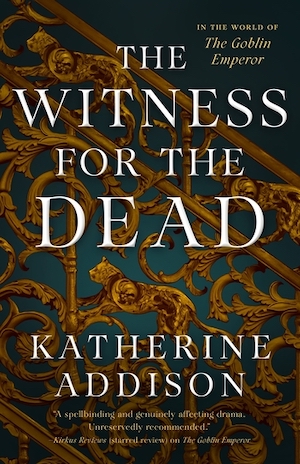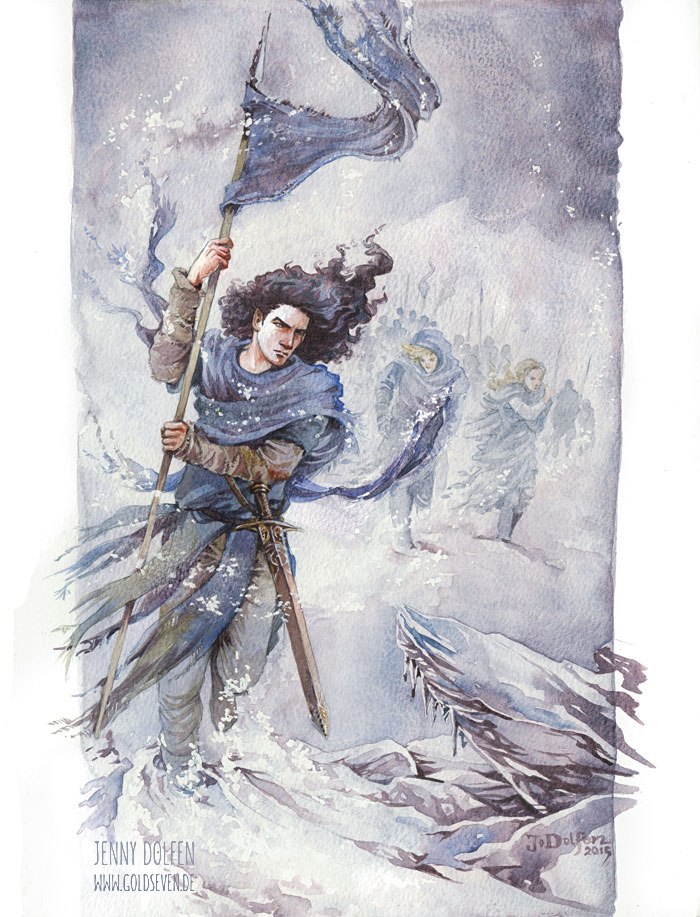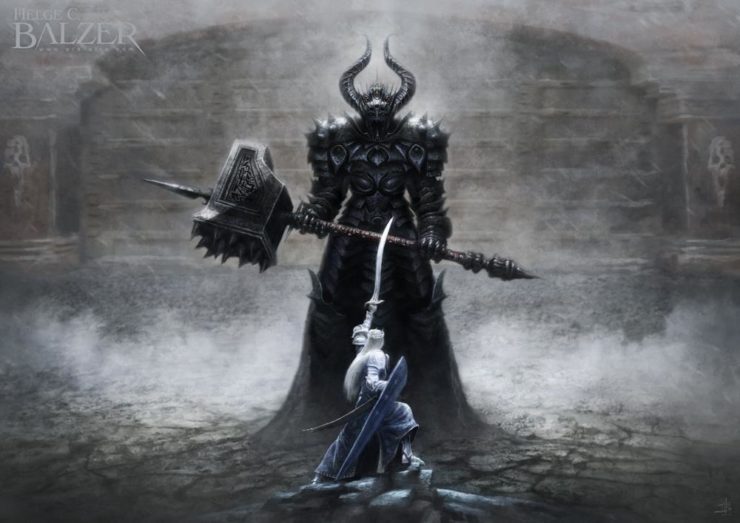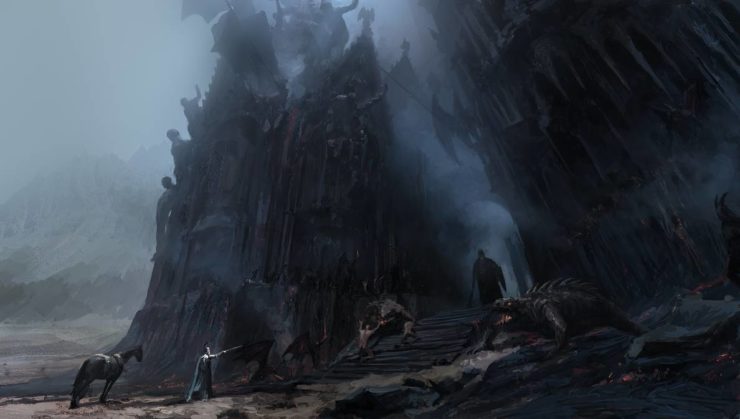In this biweekly series, we’re exploring the evolution of both major and minor figures in Tolkien’s legendarium, tracing the transformations of these characters through drafts and early manuscripts through to the finished work. This week’s installment takes a look at the story of Fingolfin, high king of Noldor, who challenged Morgoth to single combat before the gates of Angband.
The ride of Fingolfin across Dor-nu-Fauglith to Angband’s gates is unforgettable. So too is the image of the elven king pounding upon the great gates of the dark fortress, blowing great blasts upon a silver horn, demanding that Morgoth show his face and join him in single combat. Of all the many characters scattered throughout the pages of The Silmarillion, Fingolfin is one of a handful that has always captured my imagination, so it was quite a surprise when I realized that I hadn’t yet written about him. It was an oversight that needed instant remedying.
The chronology of Fingolfin’s textual development is somewhat tortured. Numerous minor changes proliferate Tolkien’s drafts, and Fingolfin’s narrative is no exception. Genealogical shifts and revisions were common in his development: over the course of not a few drafts, Fingolfin has multiple fathers and a varying collection of siblings (see The Lays of Beleriand, hereafter LB, 22, 26, and 101 for examples). He does not appear at all in the earliest stories about Fëanor and the departure from Valinor (The Book of Lost Tales 1, hereafter BLT1 172, 193), though of course he comes to play an indispensable role in the flight of the Noldor from the realm of the Valar. Part of the difficulty is that within the drafts collection in the first few volumes of The History of Middle-earth, Tolkien’s use of the name “Fingolfin” is inconsistent. A few different characters borrow the name; and, as mentioned before, changes in family trees and other relationships were nearly constant in the early stages of Tolkien’s Silmarillion-related work.
Though it’s difficult to trace a coherent thread of development from a single origin point to the Fingolfin as we know and love him in The Silmarillion, we can say that he first appears very early in Tolkien’s writing career—before 1926, in fact (The Shaping of Middle-earth, hereafter SM, 1). Here he is called Golfin, son of Gelmir king of the “Gnomes” (Tolkien’s early word for the Elves). His brothers are Delin and Lúthien (yes, Lúthien) (SM 5-7). At this point, he is not in any way associated with Fëanor and Co. There is, on a small scrap of paper, hint of a conflict between Fëanor and a Fingolfin, but the note contains no context. Though Christopher Tolkien dates it to around the same time as the “Fingolfin son of Gelmir” draft, it is impossible to say what the note refers to (SM 9). Many early drafts are similarly vague; the earliest Annals of Valinor, for example, simply claim that “dissension awoke between Fëanor and Fingolfin,” leading to Fëanor’s betrayal in the north (SM 317).
Buy the Book


The Witness for the Dead
The next significant step comes in The Lay of the Fall of Gondolin, and soon after in the second version of The Lay of the Children of Húrin. There, for the first time, “Fingolfin as the son of Finwë (Finn) and father of Turgon emerges” (SM 53). At this point, he begins to take on more unique and individual qualities. The first major draft of the Quenta Silmarillion describes him as “the mightiest and most valiant” of the sons of Finwë (SM 106). Later revisions build on this, calling him “the strongest, the most steadfast, and the most valiant” (The Lost Road, hereafter LR, 245). In The Peoples of Middle-earth, we learn further that “Fingolfin was his father’s son, tall, dark, and proud” (PM 336).
Fingolfin only becomes Fëanor’s half-brother through a significant amount of authorial maneuvering on Tolkien’s part (LB 166-167). In fact, the first time Fingolfin and Fëanor are associated as family members, Fingolfin is the elder brother. Tolkien quickly reversed that birth order, but the draft is proof that he didn’t quite know what role Fingolfin was to play in the history of the Noldor (SM 16). Fëanor and Fingolfin don’t become half-brothers, in fact, until some time after The Lord of the Rings was published—when Tolkien for the first time began to question the “death” of Míriel and her separation from Finwë. The invention of Indis, Finwë’s second wife, thus introduced a useful foundation for much of the tension and conflict between Fëanor and his younger half-brothers.
One element that does appear early, despite the constant shifting of family dynamics, is Morgoth’s lie that Fingolfin is eager to usurp Fëanor’s place (SM 109, for example). This rumor then becomes the impetus for the tensions between the two groups; Fingolfin does still follow Fëanor from the precursor to Valinor, but he does so only because he doesn’t want to abandon his people (SM 19). As in the published Silmarillion, he and his followers are betrayed, forced to wander the Grinding Ice until they find passage to Middle-earth (SM 20).
As I mentioned above, the full complexity of the conflict between Fingolfin and Fëanor emerges only slowly. They are both proud, ambitious, and somewhat covetous of their positions among the Noldor: in fact, a later revision of the Quenta Silmarillion says that the siblings “grew proud and jealous each of his rights and his possessions” (Morgoth’s Ring, hereafter MR, 276). The natural tension that develops between them as rivals is stoked by the rumors of Morgoth—not all of which were untrue. What becomes clear is that Fingolfin learns from many of his mistakes and eventually becomes more willing to take the thoughts and needs of others into account—whereas Fëanor is focused on his own desires even in his dying breath (literally).
As the narratives develop, we also begin to see more nuance to Fingolfin’s motivations in leaving Valinor. This comes especially in the later versions of the Quenta Silmarillion, when Tolkien introduces the (supposed) reconciliation of Fingolfin and Fëanor before the throne of Manwë. This comes after the scene (added later, actually) in which Fëanor sets his sword against Fingolfin’s chest and threatens him. Fëanor is exiled, but returns later, recalled by Manwë in the hopes that the rift can be healed.
In one version of the departure of the Noldor from Valinor, Tolkien emphasizes even more strongly Fingolfin’s reluctance to leave by citing the promise he makes before Manwë—that he will follow where his elder brother leads (MR 197). This assertion apparently led Tolkien to return to the scene of reconciliation to intensify Fingolfin’s vow: now he says: “Half-brother in blood, full brother in heart I will be. Thou shalt lead and I will follow” (MR 287). Of course, these promises have disastrous effects that no one foresees; but Tolkien also uses them to demonstrate that Fingolfin will go against even his better judgment to keep a vow. Fëanor, on the other hand, will be just as quick to cast loyalty to the winds.
Not only that—in choosing to follow Fëanor in defiance of the gods, Fingolfin is also choosing to leave his wife behind. Anairë, recognizing the danger of flouting the decrees of the Valar and unwilling to leave her good life in Valinor, watches her husband and all four of their children march out into the unknown (The War of the Jewels, hereafter WJ, 323; PM 344-345). She presumably never sees them again. It is hard to know what to make of this. Both seem partly to blame for their decision to abandon members of their families; but the narrative itself never blames them. There is none of the waffling between accusation and forgiveness that attends Míriel’s story; nor is there any record of growing coldness and distance between Fingolfin and Anairë, as there is between Fëanor and his wife Nerdanel (who also, incidentally, elects to stay behind). Anairë is never mentioned again, and we don’t get as much as a single peek into her life or the justifications she had for staying behind.
All the same, Fingolfin goes, experiences with horror and foreboding the first Kinslaying and the damning response of the Valar. Despite all his many misgivings he doesn’t turn back, and is rewarded for his loyalty with not just a simple, straightforward betrayal—but with the desertion of himself and his followers to what, in Fëanor’s mind, should have been a brutal death in the freezing wastes of the Helcaraxë.

Against all odds, however, and with the help of his brother, his niece Galadriel, and his children, Fingolfin leads his people through those wastes onto the bitter shores of Middle-earth. Their arrival literally marks a new age in the world’s history: as they set foot in Middle-earth a simultaneous moon- and sunrise herald the end of the First Age (LR 131). They blow their trumpets in the first light of dawn as, for the first time, flowers open their faces to the sky, and the bright banners glimmer in the early morning breeze.
In some versions of the story, Fingolfin and his people march straight to the gates of Angband and lay their grievances, literally, at Morgoth’s door (see SM 352, for example). In all versions, they eventually meet with the remnants of Fëanor’s people, and find in the process that Fëanor himself is dead and his eldest son held captive by Morgoth. An uneasy peace between the factions is restored when Fingon rescues Maedhros and the latter gives up his claim to the high-kingship. Fingolfin and Maedhros become consistent and strong allies even when others of Fëanor’s sons grumble under their breath about the association. For a long time, the alliance remains strong. According to several tales, “Morgoth feared and hated the house of Fingolfin, both because they had scorned him in Valinor” (LR 344), because they “had hearkened never to his lies and blandishments” (SM 145), and because they “had the friendship of Ulmo” (WJ 77).
Slowly, however, Fingolfin’s people fall into a stultifying contentment. The king struggles to draw his people together into an effective resistance because they’re too happy with their rich lives in a rich land (LR 306-307). His schemes begin to fall flat. He fails to rouse them again to anger and action.
The final attempt against Morgoth in Fingolfin’s lifetime is the Battle of Sudden Flame. It turns out, as can be anticipated from its name, horribly. A defection of an entire unit at a crucial point turns the tide against the elvish alliance. Many great warriors are slaughtered on the battlefield. The dead lie in great piles, their bodies mutilated, too many to bury properly.
Fingolfin is furious. Grief and anger drive him to suicidal madness: “his own death he sought in rage and anguish seeing the defeat of his people” (SM 128).
Taking in hand his great horse, Rochallor, he “rode forth alone, and none might restrain him” (Sil 153).
He passed over Dor-nu-Fauglith like a wind amid the dust, and all that beheld his onset fled in amaze, thinking that Orome himself was come: for a great madness of rage was upon him, so that his eyes shone like the eyes of the Valar. Thus he came alone to Angband’s gates, and he sounded his horn, and smote once more upon the brazen doors, and challenged Morgoth to come forth to single combat. And Morgoth came. (Sil 153)
If I had to choose a single sentence in all of The Silmarillion as the one that has consistently captivated me the most, I’d choose that final one: “And Morgoth came.” It never fails to send chills down my spine. I can see so clearly the moment when “Morgoth came, climbing slowly from his subterranean throne, and the rumour of his feet was like thunder underground. And he […] stood before the King like a tower, iron-crowned, and his vast shield, sable unblazoned, cast a shadow over him like a stormcloud. But Fingolfin gleamed beneath it as a star” (Sil 153).
He draws Ringil, his icy sword, in opposition to Morgoth’s great mace Grond, hammer of the underworld. And in defiance of the darkness he stands before the Dark Lord like a bright flame, refusing to cower, tired of failure and inaction.
No other deed matches this one, says Tolkien, save the valor of Lúthien as she sang before Morgoth to recover a Silmaril (SM 135). And it moves me. There is so much we don’t know about Fingolfin—so much more that Tolkien might have said. Is his mother name “Ingoldo,” symbolizing “that he was partly of both the Ingar (the people of Ingwe) […], and the Noldor,” as Morgoth’s Ring suggests (230, 253)? Or was it “Arakáno,” “high chieftain,” as we read in the “Shibboleth of Fëanor” (WJ 360)? What happened to Anairë, and why did he leave her? How did he endure the loss of most of his children as they pursued their own destinies? And why, in some of Tolkien latest revisions of the Silmarillion stories, is Fingolfin missing entirely?

In the midst of unknowns, this moment shines, unforgettable. It has been immortalized by artists and retold in fan fiction. Fingolfin’s choice was doubtless foolhardy and unwise, but every reading only increases my awe at his courage in the face of utter despair. Fingolfin isn’t going down without a fight, and he isn’t going to give up when defeat has just crippled his friends and allies. He advances in anger, maybe, but he does ultimately make a difference.
It’s also important to acknowledge, however, that as great and courageous as it was, Fingolfin’s deed isn’t celebrated by his kin. It so paralyzes them with grief that the Elves, who write songs about practically everything (even griefs that aren’t their own) never manage to sing of it (Sil 154). They are heartbroken. (To be fair, the story does appear in The Lays of Beleriand, as part of the beautiful and moving Canto XII in “The Lay of Leithian,” but it remained unfinished and Tolkien apparently came to the belief that this was one grief that the Elves couldn’t find words to express.)
Fingon moves himself to take up the mantle his father left behind, but in the face of his father’s death he is so afraid of Morgoth’s reach that he separates himself from his own son, sending the young Gil-galad to the Havens for safety’s sake (Sil 154). Fingolfin’s death signals the slow collapse of the alliance that had long held Beleriand in freedom.
What Tolkien seems to be suggesting is that even the most heroic and admirable of acts always affect other people. Fingolfin didn’t stop to count the cost; instead, he sacrificed his life on a literal suicide mission. Tolkien’s tellings of the meeting seem to waffle between awe and sorrow, reminding us to be heroic, but also asking us to keep in mind how our actions may hurt those we love and lead. Be brave, but compassionate. Courageous, but kind. Driven, but thoughtful. Not even the most wise among us can see every end, and it might just be the case that it’s best not to face the darkness alone. Take someone as you can trust. You won’t be sorry.
Megan N. Fontenot is a dedicated Tolkien scholar and fan who has been abundantly encouraged and inspired by the examples and influence of Tolkien’s characters. Catch her on Twitter @MeganNFontenot1 and feel free to request a favorite character while you’re there!










